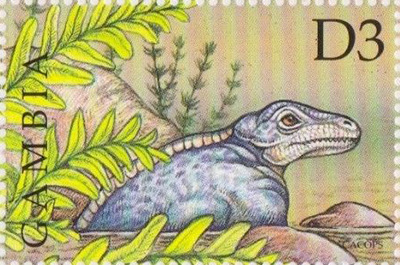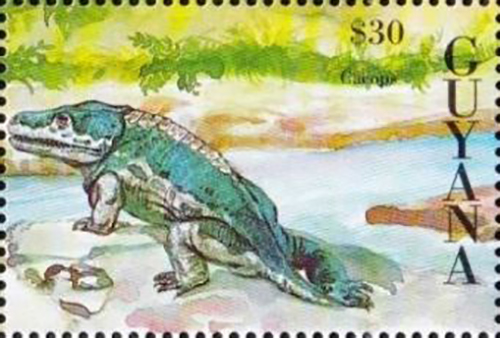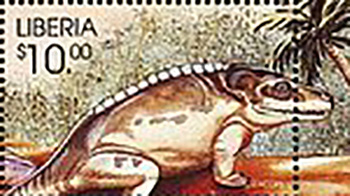Cacops aspidephorus Williston, 1910

(Da: it.wikipedia.org)
Phylum: Chordata Haeckel, 1874
Subphylum: Vertebrata Cuvier, 1812
Classe: Amphibia Gray 1825
Ordine: Temnospondyli Zittel, 1888
Famiglia: Dissorophidae Boulenger, 1902
Genere: Cacops Williston, 1910
Specie e sottospecie
Cacops morrisi Reisz et al., 2009 - Cacops woehri Fröbisch and Reisz, 2012.
Descrizione
Questo animale era lungo circa 50 centimetri e possedeva un corpo tarchiato sorretto da zampe robuste. Il corpo era percorso da una pesante corazza lungo tutto il dorso, formata da osteodermi. La coda era corta e il cranio era enorme, dotato di grandi orbite e di fauci notevoli. Altra caratteristica del cranio era data da una profonda incisura otica nella parte posteriore; questa incisura, al contrario di molti altri anfibi simili, era chiusa da una barra ossea. Recenti ritrovamenti descritti nel 2009 evidenziano come questa struttura fosse una prova evidente della presenza di una membrana timpanica, adatta a sentire i suoni aerei ad alta frequenza. Nel Permiano inferiore il clima iniziò a diventare sempre più secco, e molti anfibi si evolsero per trasformarsi in animali compiutamente terrestri. È il caso dei dissorofidi (Dissorophidae), a cui appartiene il Cacops (il cui nome significa "aspetto brutto"). Probabilmente questo animale si nutriva di piccoli vertebrati o di insetti, che cacciava muovendosi attivamente sul terreno. Il cacope deve essere stato uno degli anfibi dell'epoca meno dipendenti dall'ambiente acquatico, e probabilmente nel suo habitat era uno dei massimi predatori.
Diffusione
Vissuto all'inizio del Permiano (circa 275 milioni di anni fa) in Nordamerica.
Bibliografia
–Williston, S. W. (1910). "Cacops, Desmospondylus; new genera of Permian vertebrates" (PDF). Geological Society of America Bulletin. 21 (1): 249-284.
–Fröbisch, Nadia B.; Reisz, Robert R. (2012). "A new species of dissorophid (Cacops woehri) from the Lower Permian Dolese Quarry, near Richards Spur, Oklahoma". Journal of Vertebrate Paleontology. 32 (1): 35-44.
–Reisz, Robert R.; Schoch, Rainer R.; Anderson, Jason S. (2009). "The armoured dissorophid Cacops from the Early Permian of Oklahoma and the exploitation of the terrestrial realm by amphibians". Naturwissenschaften. 96 (7): 789-796.
–Bolt, John R. (1974). "Armor of dissorophids (Amphibia: Labyrinthodontia): an examination of its taxonomic use and report of a new occurrence". Journal of Paleontology. 48 (1): 135-142. JSTOR 1303113.
–Sullivan, Corwin; Reisz, Robert R.; May, William J. (2000). "Large dissorophoid skeletal elements from the Lower Permian Richards Spur Fissures, Oklahoma, and their paleoecological implications". Journal of Vertebrate Paleontology. 20 (3): 456-461.
–Schoch, Rainer R.; Milner, Andrew, R. (2014). Sues, Hans-Dieter (ed.). Handbuch der Paläoherpetologie Part 3A2. Temnospondyli. Stuttgart: Dr. Verlag Friedrich Pfeil. ISBN 9783931516260.
–Fröbisch, N. B.; Brar, A.; Reisz, R. R. (27 January 2015). "New specimen of Cacops woehri indicates differences in the ontogenetic trajectories among cacopine dissorophids". Fossil Record. 18 (1): 73-80.
–Gee, Bryan M.; Reisz, Robert R. (2018). "Cranial and postcranial anatomy of Cacops morrisi , a eucacopine dissorophid from the early Permian of Oklahoma". Journal of Vertebrate Paleontology. 38 (2): e1433186.
–Bolt, John R. (1977). "Cacops (Amphibia, Labyrinthodontia) from the Fort Sill Locality, Lower Permian of Oklahoma". Fieldiana: Geology. 37: 61-73.
–Dilkes, David W. (2009). "Comparison and biomechanical interpretations of the vertebrae and osteoderms of Cacops aspidephorus and Dissorophus multicinctus (Temnospondyli, Dissorophidae)". Journal of Vertebrate Paleontology. 29 (4): 1013-1021.
–Dilkes, D.; Brown, L. E. (2007). "Biomechanics of the vertebrae and associated osteoderms of the Early Permian amphibian Cacops aspidephorus". Journal of Zoology. 271 (4): 396-407.
–Olson, Everett C. (1956). Fauna of the Vale and Choza : 12, a new Trematopsid amphibian from the Vale formation. Chicago Natural History Museum. pp. 323-328.
–Milner, Andrew R. (1985). "On the identity of Trematopsis seltini (Amphibia: Temnospondyli) from the Lower Permian of Texas". Neues Jahrbuch für Geologie und Paläontologie. 6: 357-367.
–Müller, Johannes; Tsuji, Linda A. (12 September 2007). "Impedance-matching hearing in Paleozoic reptiles: evidence of advanced sensory perception at an early stage of amniote evolution". PLoS ONE. 2 (9): e889.

|
Data: 01/08/1999
Emissione: Animali preistorici Stato: Gambia |
|---|

|
Data: 10/03/1993
Emissione: Animali preistorici Stato: Guyana |
|---|

|
Data: 22/11/1999
Emissione: Animali preistorici Stato: Liberia |
|---|